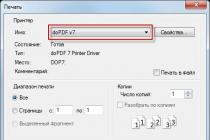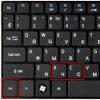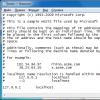This rechargeable LED headlamp has a range of up to 200 meters. It uses Cree Q5 LED, and its beam can be seen at a distance of 800m. The maximum convenience in using this model is provided by the presence of three glow modes: strobo, bright and economical. Material - anodized aluminum and high-quality plastic. On the back of the flashlight is a battery compartment with a glowing red inscription "LED HEADLIGHT".
Rechargeable LED headlamp
The service life of the flashlight is up to 10 million hours. A convenient yaw function allows you to change the beam direction. The flashlight is powered by two 3.7V Li-ion batteries with a capacity of 6800 mAh. In addition to it, there are two chargers - from the 220V network and from the car cigarette lighter.

Key Features of LED Rechargeable Head Light K13:
- LED - Cree Q5
- Modes - strobe, bright, economical
- Beam focusing - yes
- Housing material - plastic + anodized aluminum
- Power - 2 Li-ion batteries 3.7V with a capacity of 6800 mAh


After working for about a year, my LED Headlight XM-L T6 headlamp began to turn on every once in a while, or even turn off without a command. Soon it stopped turning on completely.
First of all, I thought that the battery in the battery compartment was moving away.
To illuminate the rear indicator LED HEADLIGHT, a conventional red SMD LED is used. It is marked on the board as LED. It illuminates a white plastic plate.

Since the battery compartment is located on the back of the head, such an indicator is clearly visible at night.

Obviously it will not interfere with cycling and walking along road routes.

Through a 100 ohm resistor, the positive output of the red SMD LED is connected to the drain of the MOSFET FDS9435A. Thus, when the flashlight is turned on, voltage is supplied to both the main Cree XM-L T6 XLamp LED and the low-power red SMD LED.
Understood the main details. Now let me tell you what went wrong.
When you press the button to turn on the flashlight, you can see that the red SMD LED starts to shine, but very dimly. The operation of the LED corresponded to the standard operating modes of the flashlight (maximum brightness, low brightness and strobe). It became clear that the control chip U1 (FM2819) is most likely working.
Since it normally responds to pressing a button, then perhaps the problem lies in the load itself - a powerful white LED. Having unsoldered the wires going to the Cree XM-L T6 LED and connected it to a homemade power supply, I made sure that it was working.
When measuring, it turned out that in the maximum brightness mode, the drain of the FDS9435A transistor is only 1.2V. Naturally, this voltage was not enough to power the powerful Cree XM-L T6 LED, but it was enough for the red SMD LED to make its crystal glow dimly.
It became clear that the FDS9435A transistor, which is involved in the circuit as an electronic key, is faulty.
I did not select anything to replace the transistor, but bought the original P-channel PowerTrench MOSFET FDS9435A from Fairchild. Here is his appearance.

As you can see, on this transistor there is a complete marking and a distinguishing mark of the company Fairchild ( F ) that produced this transistor.
Comparing the original transistor with the one installed on the board, the thought crept into my head that a fake or a less powerful transistor was installed in the flashlight. Perhaps even marriage. Still, the lantern did not have time to serve even a year, and the power element had already "thrown its hooves".
The pinout of the FDS9435A transistor is as follows.

As you can see, there is only one transistor inside the SO-8 package. Pins 5, 6, 7, 8 are combined and are the drain pin ( D rain). Pins 1, 2, 3 are also connected together and are the source ( S ource). 4th pin is the shutter ( G ate). It is to him that the signal comes from the control chip FM2819 (U1).
As a replacement for the FDS9435A transistor, you can use APM9435, AO9435, SI9435. All of these are analogues.

You can solder the transistor using both conventional methods and more exotic ones, for example, Rosé alloy. You can also use the brute force method - cut the leads with a knife, dismantle the case, and then solder the leads remaining on the board.
After replacing the FDS9435A transistor, the headlamp began to work properly.

This story about the repair is over. But, if I were not a curious radio mechanic, I would leave everything as it is. Works fine. But some things didn't bother me.
Since initially I did not know that the microcircuit marked 819L (24) is FM2819, armed with an oscilloscope, I decided to see what signal the microcircuit sends to the transistor gate in different operating modes. It's interesting.
When the first mode is turned on, -3.4 ... 3.8V is supplied to the gate of the FDS9435A transistor from the FM2819 chip, which practically corresponds to the voltage on the battery (3.75 ... 3.8V). Naturally, a negative voltage is applied to the gate of the transistor, since it is a P-channel.
In this case, the transistor opens completely and the voltage on the Cree XM-L T6 LED reaches 3.4 ... 3.5V.
In the minimum glow mode (1/4 brightness), about 0.97V comes to the FDS9435A transistor from the U1 chip. This is if you take measurements with an ordinary multimeter without bells and whistles.
In fact, in this mode, a PWM signal (pulse-width modulation) comes to the transistor. By connecting the oscilloscope probes between the "+" power supply and the gate terminal of the FDS9435A transistor, I saw this picture.
The picture of the PWM signal on the oscilloscope screen (time / division - 0.5; V / division - 0.5). The sweep time is mS (milliseconds).

Since a negative voltage is applied to the gate, the "picture" on the oscilloscope screen is flipped. That is, now the photo in the center of the screen shows not an impulse, but a pause between them!
The pause itself lasts about 2.25 milliseconds (mS) (4.5 divisions of 0.5mS). At this point, the transistor is closed.
The transistor then opens at 0.75 mS. In this case, the XM-L T6 LED is energized. The amplitude of each pulse is 3V. And, as we remember, I measured only 0.97V with a multimeter. This is not surprising, since I measured the constant voltage with a multimeter.
This is the moment on the oscilloscope screen. The time/div switch was set to 0.1 to better define the pulse width. The transistor is open. Do not forget that a minus "-" comes to the shutter. The momentum is reversed.

S = (2.25mS + 0.75mS) / 0.75mS = 3mS / 0.75mS = 4. Where,
S - duty cycle (dimensionless value);
Τ - repetition period (milliseconds, mS). In our case, the period is equal to the sum of the on (0.75 mS) and pause (2.25 mS);
τ is the pulse duration (milliseconds, mS). We have it 0.75mS.
It is also possible to define fill factor(D), which in the English-speaking environment is called Duty Cycle (often found in any datasheets for electronic components). It is usually specified as a percentage.
D = τ/Τ = 0.75/3 = 0.25 (25%). Thus, in the dimmed mode, the LED is only on for a quarter of the period.
When I did the calculations for the first time, my fill factor was 75%. But then, when I saw a line about the 1/4 brightness mode in the datasheet on FM2819, I realized that I screwed up somewhere. I just mixed up the pause and the pulse duration in some places, because out of habit I took the minus "-" on the shutter for a plus "+". Therefore, it turned out the other way around.
In the "STROBE" mode, I could not see the PWM signal, since the oscilloscope is analog and quite old. I failed to synchronize the signal on the screen and get a clear image of the pulses, although its presence was visible.
Typical switching circuit and pinout of the FM2819 microcircuit. Maybe someone will come in handy.

I was haunted by some points related to the operation of the LED. I had never dealt with LED lights before, but here I wanted to figure it out.
When I looked through the datasheet for the Cree XM-L T6 LED, which is installed in the flashlight, I realized that the value of the current limiting resistor is too small (0.13 Ohm). Yes, and on the board one seat for the resistor was free.
When I was browsing the Internet in search of information about the FM2819 chip, I saw photos of several printed circuit boards of similar lights. On some, four 1 Ohm resistors were soldered, and on some, an SMD resistor marked "0" (jumper), which, in my opinion, is generally a crime.
The LED is a non-linear element, and therefore, a current-limiting resistor must be connected in series with it.
If you look at the datasheet for the LEDs of the Cree XLamp XM-L series, you will find that their maximum supply voltage is 3.5V, and the nominal voltage is 2.9V. In this case, the current through the LED can reach a value of 3A. Here is the chart from the datasheet.

The rated current for such LEDs is considered to be a current of 700 mA at a voltage of 2.9V.
Specifically, in my flashlight, the current through the LED was 1.2 A at a voltage of 3.4 ... 3.5 V on it, which is clearly a bit too much.
To reduce the forward current through the LED, I soldered four new 2.4 ohm resistors (size 1206) instead of the previous resistors. Got a total resistance of 0.6 ohms (power dissipation 0.125W * 4 = 0.5W).

After replacing the resistors, the direct current through the LED was 800 mA at a voltage of 3.15V. So the LED will work at a milder thermal regime, and, hopefully, will last a long time.

Since the 1206 size resistors are designed for a dissipation power of 1/8W (0.125 W), and in the maximum brightness mode, about 0.5 W of power is dissipated on four current-limiting resistors, it is desirable to remove excess heat from them.
To do this, I cleaned the copper polygon next to the resistors from green varnish and soldered a drop of solder onto it. This technique is often used on printed circuit boards of consumer electronic equipment.

After finalizing the electronic filling of the flashlight, I coated the printed circuit board with PLASTIK-71 varnish (electrical insulating acrylic varnish) to protect it from condensation and moisture.

When calculating the current-limiting resistor, I ran into some subtleties. The drain voltage of the MOSFET transistor should be taken as the supply voltage of the LED. The fact is that on the open channel of the MOSFET, part of the voltage is lost due to the channel resistance (R (ds) on).
The higher the current, the more voltage "settles" along the source-drain path of the transistor. For me, at a current of 1.2A, it was 0.33V, and at 0.8A - 0.08V. Also, part of the voltage drops on the connecting wires that go from the battery terminals to the board (0.04V). It would seem that such a trifle, but in total it runs 0.12V. Since under load the voltage on the Li-ion battery sags to 3.67 ... 3.75V, then on the MOSFET drain it is already 3.55 ... 3.63V.
Another 0.5 ... 0.52V extinguishes a circuit of four parallel resistors. As a result, a voltage comes to the LED in the region of 3 with a small volt.
At the time of this writing, an updated version of the headlamp under consideration has appeared on sale. It already has a built-in Li-ion battery charge / discharge control board, as well as an optical sensor that allows you to turn on the flashlight with a palm gesture.
Such a useful thing as a headlamp is indispensable for cyclists, athletes, fishermen. In addition, it is very useful in everyday life - both at home and in the country or in the garage. This review is about one of these lamps.
The reviewed flashlight uses a bright CREE XM-L T6 LED, and also has a non-standard place for attaching the on/off button for such devices - not on the flashlight body itself, but on the side, on the head circumference elastic band.
The packaging is unremarkable - a simple cardboard box without any printing and indicating the nature of the contents.
Delivery set: flashlight, charger and adapter for euro-socket.
Charging is rated at 4.5 volts at 500 mA.
The whole design consists of four elements: the flashlight itself, adjustable elastic straps for attaching to the head, a power / mode switch button and a battery compartment located on the back of the head.
The on / off button is located on the left side and it is installed "in the gap" of the power wire going from the lamp to the battery pack.
Pressing the button is soft and clear. The button sequentially switches the following modes: bright —> dim —> flashing —> off.
There is no function for remembering the last mode, so when you turn on the flashlight, it immediately goes into the “bright” mode.
Behind, that is, on the back of the head, there is a compartment for batteries.
The lantern itself turned out to be fixed with a special clip, so if necessary it can be removed.
The direction of the luminescence of the lantern can be adjusted in steps from horizontal to vertical.
The flashlight has a "zoom" function, that is, increasing the range of the light beam using an optical lens. In the normal mode, designed for near lighting, the lens is pushed as far back as possible.
To narrow the light beam and, as a result, increase its range, it is necessary to pull the lens forward.
Behind, under the plastic grille, the metal body of the lantern is visible.
The battery compartment is a plastic box with a rubber lid. The lid tightly closes the compartment and is attached to the body with a special ring to prevent loss.
The batteries can be either one or two 18650 batteries (not included, so you need to purchase separately).
You can charge the batteries right there without removing them from the compartment. To do this, under a special rubber plug there is a corresponding connector.
Nothing unremarkable at first glance, an insert made of soft white plastic with the inscription "LED HEADLIGHT" when turned on, turns out to be nothing more than a rear signal light. Depending on the mode of operation of the flashlight, it will glow (or flash) in red.
Without zoom, maximum brightness, the flashlight is fixed on the head, the beam is directed down under the feet:
And this is what the lamp looks like in the working position, that is, on the head:
Conclusion
I liked the lantern a lot.
Bright light
Custom focus
Powered by batteries with the ability to charge them directly in the flashlight
Similarity of moisture protection in the form of rubber covers and plugs
Comfortable elastic bands that allow you to adjust the mount for comfortable wearing on any head size
Convenient location of the mode switch button
Relatively little heat during operation
And perhaps most importantly - free hands. What else is needed for a headband?
Thank you for your attention!
How to charge a headlamp with a battery? It would seem nothing complicated, however, nevertheless, there are certain rules. The use of rechargeable batteries is a convenient and environmentally friendly way of autonomous power supply of electrical equipment. Conventional rechargeable batteries can be recharged hundreds of times. Such power supplies will last three to four years, or even as much as ten years. The efficiency of batteries depends on how well you use them, how careful you are when charging them. Consider, for example, how to charge a flashlight battery.
What is a battery charger and how does it work
What happens inside a normal battery, like the one in a flashlight? When you turn on the light, you cause a chemical reaction inside the power sources, as a result of which, under the influence of the electrolyte, the electrodes begin to work, generating electricity, which is transmitted through the circuit to the light bulbs. But such a reaction cannot last indefinitely. It gradually fades and the lamp goes out.
Batteries are like travel bags: the more you put in them, the harder it is to fit anything else. Overcharging batteries is generally worse than undercharging. Excessive current leads to heating of the batteries, an increase in the level of pressure inside, the release of chemicals and even an explosion. There are chargers with a timer to help prevent overcharging the batteries.
How to charge the battery of a headlamp or other electrical device
How to properly charge the flashlight battery can be found in the instructions for the device, battery and charger. Various chargers are designed to be used with their respective batteries. This is the main rule. If you are wondering how to charge a headlamp on an 18650 battery, then the answer is: only with a suitable charger. Some flashlights are already equipped with a built-in charger or such a device is supplied additionally with the lighting fixture. All complex electronics are equipped with their specific charging: smartphones, laptops, mp3 players, etc. When buying rechargeable batteries, pay attention to the voltage and current levels indicated on the batteries. The charger must comply with these parameters. Some manufacturers of charging adapters additionally indicate with batteries which manufacturers their products are compatible with. It is possible to purchase both the charger and batteries in one set.
How to properly charge the flashlight battery:
- Use the flashlight regularly and recharge the battery regularly. Do not leave the battery fully charged or discharged for months.
- It is necessary to ensure the possibility of restoring the battery. To do this, set to charge only a discharged battery (do not drain the battery completely). As soon as the light of the flashlight began to dim, turn off the device and put it aside or put it on charge.
- Make sure the batteries match the charger.
- Do not overcharge batteries. This will damage them.
- Do not allow batteries to become very hot or cold during charging, storage or use. Of course, batteries can get hot when they are charged, but if they get hot, that's a problem.
- Don't skimp on buying a good, quality charger. This determines how long the batteries will last.
- Follow the instructions included with the products you use.
Now you know how to properly charge the flashlight battery and you can extend the life of the batteries or even the whole lighting fixture.
Inspired by other people's reviews, I bought myself a forehead protector. Attracted by the low price and good reviews. I did not disappoint, for my money - a very good flashlight on a 18650 rechargeable battery.
The flashlight was packed in a square box made of thin cardboard; apparently, due to its low weight, BIC neglected to throw away this package. 
Assembled with high quality, the material of the flashlight body and battery compartment is good. But the elastic band is weak and the clamps for changing its length are plastic and not very reliable.
The flashlight sits tightly on my, not heroic in general, “bowler hat”, so if you take it for cycling and use it all the time, I think the life of the gum will be short-lived.
By the way, I suspect that the manufacturers focused specifically on this niche, as evidenced by the design with a separate battery compartment that has a red flasher on the back wall. 






So the forehead part with a flashlight. Plastic arc for fastening with holes and has a soft rubber gasket in the central part that prevents slipping and ensures that the lamp fits in the correct position.
The flashlight is fixed in the central position, but it also has the ability to adjust the position (lower down) at an angle of up to 90 degrees.
The switch in the form of a metal button at the base of the flashlight housing allows you to switch the flashlight to one of three modes: strong light-weak light-strobe. The lens of the flashlight is small and plastic, of course. The flashlight does not remember the last position.
When switching modes, the brightness and blinking frequency of the LEDs on the back of the battery compartment also change.
The flashlight head allows you to change the focal length in the simplest way - moving back and forth along the body. So it will probably loosen up over time.
At the minimum, the LED is visible, at the maximum, a spot of light.
As usual with this design, the spot of light is a bright circle in the center and a halo around it.
The LED provides a fairly bright, blinding light at maximum, the estimated power is 3 V. The light is blue, but not very pronounced. 


The battery compartment located in the working position on the back of the head is designed for one 18650 battery. It is closed with a rubber rectangular plug attached with an “anti-loss” in the form of a ring. The cap is slightly curved for a comfortable fit on the head.
The battery compartment and the flashlight are connected with a wire bent by a spring. The wire is good. I can’t say anything about the cross section - I didn’t understand it, but the insulation is good.
I summarize. Advantages:
- powerful enough for use in everyday life LED;
- the presence of three modes of operation: strong light, weak light, stroboscope;
- the ability to change the angle of inclination of the lantern;
- the presence of a "flashing light" of red light on the rear wall of the battery compartment;
- powered by one 18650 lithium battery, providing a significant resource of the flashlight;
- quite ergonomic design of the flashlight;
- high-quality assembly and materials of the flashlight and battery compartment;
- during operation, the flashlight does not heat up very much;
- The price is very democratic.
Flaws:
- the quality of the elastic band and fixators of its position is mediocre;
- constantly blinking, even in the off state, the LED on the back wall of the battery compartment (you need to hide the flashlight in the table, because it will be annoying at night);
- the flashlight does not remember the last position and when you turn it on, you need to select the desired mode each time;
- the design of the focus regulator is not the most successful, it is possible to move the flashlight head;
- small plastic lens














